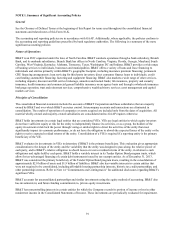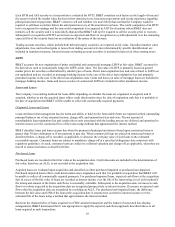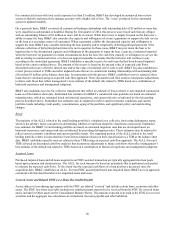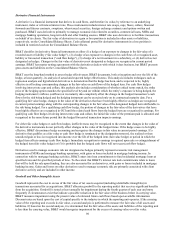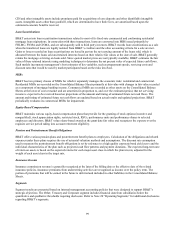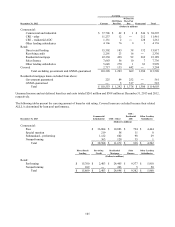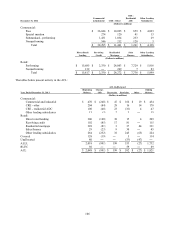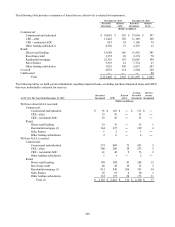BB&T 2013 Annual Report Download - page 98
Download and view the complete annual report
Please find page 98 of the 2013 BB&T annual report below. You can navigate through the pages in the report by either clicking on the pages listed below, or by using the keyword search tool below to find specific information within the annual report.98
Derivative Financial Instruments
A derivative is a financial instrument that derives its cash flows, and therefore its value, by reference to an underlying
instrument, index or referenced interest rate. These instruments include interest rate swaps, caps, floors, collars, financial
forwards and futures contracts, swaptions, when-issued securities, foreign exchange contracts and options written and
purchased. BB&T uses derivatives primarily to manage economic risk related to securities, commercial loans, MSRs and
mortgage banking operations, long-term debt and other funding sources. BB&T also uses derivatives to facilitate transactions
on behalf of its clients. The fair value of derivatives in a gain or loss position is included in other assets or liabilities,
respectively, on the Consolidated Balance Sheets. Cash collateral posted for derivative instruments in a loss position is
included in restricted cash on the Consolidated Balance Sheets.
BB&T classifies its derivative financial instruments as either (1) a hedge of an exposure to changes in the fair value of a
recorded asset or liability (“fair value hedge”), (2) a hedge of an exposure to changes in the cash flows of a recognized asset,
liability or forecasted transaction (“cash flow hedge”), (3) a hedge of a net investment in a subsidiary, or (4) derivatives not
designated as hedges. Changes in the fair value of derivatives not designated as hedges are recognized in current period
earnings. BB&T has master netting agreements with the derivatives dealers with which it does business, but BB&T presents
gross assets and liabilities on the Consolidated Balance Sheets.
BB&T uses the long-haul method to assess hedge effectiveness. BB&T documents, both at inception and over the life of the
hedge, at least quarterly, its analysis of actual and expected hedge effectiveness. This analysis includes techniques such as
regression analysis and hypothetical derivatives to demonstrate that the hedge has been, and is expected to be, highly
effective in off-setting corresponding changes in the fair value or cash flows of the hedged item. For cash flow hedges
involving interest rate caps and collars, this analysis also includes consideration of whether critical terms match, the strike
price of the hedging option matches the specified level beyond (or within) which the entity’s exposure is being hedged, the
hedging instrument’s inflows (outflows) at its maturity date completely offset the change in the hedged transaction’s cash
flows for the risk being hedged and the hedging instrument can be exercised only on its contractual maturity date. For a
qualifying fair value hedge, changes in the value of the derivatives that have been highly effective as hedges are recognized
in current period earnings along with the corresponding changes in the fair value of the designated hedged item attributable to
the risk being hedged. For a qualifying cash flow hedge, the portion of changes in the fair value of the derivatives that have
been highly effective are recognized in OCI until the related cash flows from the hedged item are recognized in earnings. For
qualifying cash flow hedges involving interest rate caps and collars, the initial fair value of the premium paid is allocated and
recognized in the same future period that the hedged forecasted transaction impacts earnings.
For either fair value hedges or cash flow hedges, ineffectiveness may be recognized to the extent that changes in the value of
the derivative instruments do not perfectly offset changes in the value of the hedged items. If the hedge ceases to be highly
effective, BB&T discontinues hedge accounting and recognizes the changes in fair value in current period earnings. If a
derivative that qualifies as a fair value or cash flow hedge is terminated or the designation removed, the realized or then
unrealized gain or loss is recognized into income over the life of the hedged item (fair value hedge) or period in which the
hedged item affects earnings (cash flow hedge). Immediate recognition in earnings is required upon sale or extinguishment of
the hedged item (fair value hedge) or if it is probable that the hedged cash flows will not occur (cash flow hedge).
Derivatives used to manage economic risk not designated as hedges primarily represent economic risk management
instruments of MSRs and mortgage banking operations, with gains or losses included in mortgage banking income. In
connection with its mortgage banking activities, BB&T enters into loan commitments to fund residential mortgage loans at
specified rates and for specified periods of time. To the extent that BB&T’s interest rate lock commitments relate to loans
that will be held for sale upon funding, they are also accounted for as derivatives, with gains or losses included in mortgage
banking income. Gains and losses on other derivatives used to manage economic risk are primarily associated with client
derivative activity and are included in other income.
Goodwill and Other Intangible Assets
Goodwill represents the cost in excess of the fair value of net assets acquired (including identifiable intangibles) in
transactions accounted for as acquisitions. BB&T allocates goodwill to the reporting unit(s) that receives significant benefits
from the acquisition. Goodwill is tested at least annually for impairment during the fourth quarter of each year and more
frequently if circumstances exist that indicate a possible reduction in the fair value of the business below its carrying value.
BB&T measures impairment using the present value of estimated future cash flows based upon available information.
Discount rates are based upon the cost of capital specific to the industry in which the reporting unit operates. If the carrying
value of the reporting unit exceeds its fair value, a second analysis is performed to measure the fair value of all assets and
liabilities. If, based on the second analysis, it is determined that the fair value of the assets and liabilities of the reporting unit
is less than the carrying value, BB&T would recognize impairment for the excess of carrying value over fair value.





